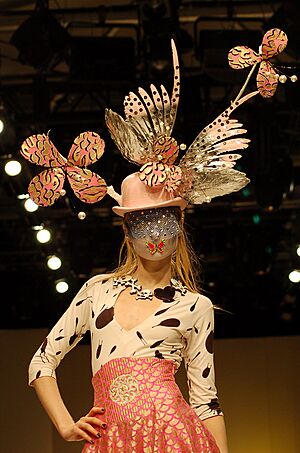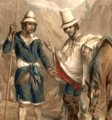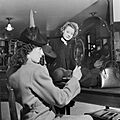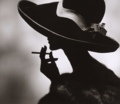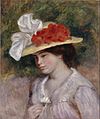Hat facts for kids
A hat is a type of covering for your head. There are many different kinds of hats!
Hats are worn differently around the world. Some hats are for women, some for men, and some for everyone. Babies and children also wear hats. Some hats are even just for decoration and not worn at all. People who make hats for men are called hatters, and those who make hats for women are called milliners. Many groups in different countries wear special hats or caps.
Some hats show a person's special job or role. For example, bishops wear a hat called a mitre. In the past, hats could even show political ideas. For instance, the Cap of Liberty was a symbol for a group in France called the Jacobins.
Here are some examples of hats:
- baseball cap: Worn by baseball players and many others.
- beret: A soft, round cap often worn by artists or military members.
- bowler hat: A hard, round hat, often worn by men in certain jobs long ago.
- coonskin cap: A hat made from raccoon fur, worn by hunters in the past.
- fedora: A soft felt hat with a special shape.
- fez: A red, cone-shaped hat, common in some Islamic countries.
- helmet: A strong hat worn for protection, like by soldiers or motorcyclists.
- mitre: A tall, pointed hat worn by bishops during religious ceremonies.
- riding helmet: A helmet worn by people who ride horses.
Types of Hats
This table shows some common and famous hats.
| Name | Description |
|---|---|
| Ascot cap | A hard cap for men, similar to a flat cap but more rounded. |
| Balmoral bonnet | A traditional Scottish cap worn with Scottish Highland clothing. |
| Baseball cap | A soft cap with a rounded top and a stiff front brim. |
| Beanie | A cap without a brim, once popular with schoolboys. In some places, it means a knitted winter hat. |
| Bearskin | A tall, furry hat worn by the King's Guards at Buckingham Palace in London, England. |
| Beret | A soft, round cap, often made of wool. It is linked to Basque people, France, and the military. |
| Bicorne | A hat with a wide brim folded up to make a two-pointed shape. Napoleon often wore one. |
| Bowler / Derby | A hard felt hat with a rounded top, first made in 1850. In the United States, it is called a Derby. |
| Chullo | A Peruvian or Bolivian hat with ear-flaps, made from animal wool. |
| Cloche hat | A bell-shaped hat for ladies that was very popular in the 1920s. |
| Cricket cap | A soft cap traditionally worn by cricket players. |
| Sombrero Cordobés | A flat-brimmed, flat-topped hat from Córdoba, Spain. It is linked to flamenco dancing. |
| Conical Asian hat | A cone-shaped straw hat from East and Southeast Asia. |
| Coonskin cap | A hat made from raccoon skin and fur. It was worn by American frontiersmen in the 1700s and 1800s. |
| Custodian helmet | A helmet traditionally worn by British police officers when walking patrol. |
| Deerstalker | A warm tweed cap with brims and ear-flaps. It is famously worn by the detective Sherlock Holmes. |
| Fedora | A soft felt hat with a medium brim and a crease on top. |
| Fez | A red felt hat shaped like a cone, common in Arab-speaking countries. |
| Fulani hat | A cone-shaped hat made of plant fiber and leather, worn by Fulani men in West Africa. |
| Keffiyah | A three-piece head covering from Arab countries, including a skull cap, scarf, and black band. |
| Hard hat | A strong, rounded helmet used in workplaces like construction sites to protect the head. |
| Kippah | A small, round cap worn by Jewish people to cover their heads. |
| Kufi | A cap without a brim, worn by people in Africa and the African diaspora. |
| Mitre | A special hat worn by bishops in the Roman Catholic, Eastern Orthodox, and Anglican Communion churches. |
| Montera | A crocheted hat worn by bullfighters. |
| Panama | A straw hat made in Ecuador. |
| Phrygian Cap | A soft, cone-shaped cap that bends forward. It often stands for freedom. The cartoon characters The Smurfs wear white Phrygian caps. |
| Pillbox hat | A small hat with straight sides, a flat top, and no brim. |
| Pith Helmet | A light, stiff helmet covered in cloth, worn by Europeans in tropical areas in the 1800s. |
| Rastacap | A tall, round, often colorful, crocheted cap worn by Rastafarians to hold their dreadlocks. |
| Santa Hat | A floppy, pointed red hat with white fur trim, linked to Christmas. |
| Sombrero | A Mexican hat with a cone-shaped top and a very wide, round brim. |
| Top hat | A tall, flat-topped, cylinder-shaped hat worn by men in the 1800s and early 1900s. Cartoon characters like Uncle Sam often wear them. |
| Toque | (Also called a "chef's hat") A tall, pleated, brimless hat traditionally worn by chefs. |
| Tricorne | A soft hat with a low top and a wide brim pinned up in three places, making a triangle shape. Worn by Europeans in the 1700s. |
| Tuque | In Canada, this is a knitted hat worn in winter. It is also known as a ski cap or beanie in other places. |
| Turban | A head covering made from a long piece of cloth wrapped around the head. |
| Ushanka | A Russian fur hat with ear-flaps that can be folded down. |
| Zucchetto | A small skullcap worn by religious leaders, especially in Roman Catholicism. |
Hat Sizes
Hat sizes are found by measuring the distance around a person's head. You measure about 1 centimeter (or half an inch) above the ears. The size might be given in inches or centimeters, depending on who made the hat.
Some hats, like hard hats and baseball caps, can be adjusted to fit different head sizes. Cheaper hats often come in general sizes like small, medium, large, or extra large. However, what "medium" means can be different for each hat maker or style!
Related pages
Images for kids
-
An Ancient Greek statue of a lady with a sun hat, from Tanagra, around 325–300 BC.
-
New York City, 1918: A large crowd, almost all wearing hats.
-
The hat department of Bourne & Hollingsworth in London in 1942. Hats were not strictly rationed during wartime Britain, leading to many new styles.
-
Pope John Paul II wearing a zuchetto.
-
Woman in a Flowered Hat (1889), by Pierre-Auguste Renoir: A straw hat with flowers and ribbons.
-
Left to right: Top-hat, peaked cap, Borsalino, bowler hat (Sweden, early 1900s).
-
A hat shop from about 1900 inside the Roscheider Hof Open Air Museum.
See also
 In Spanish: Sombrero para niños
In Spanish: Sombrero para niños



